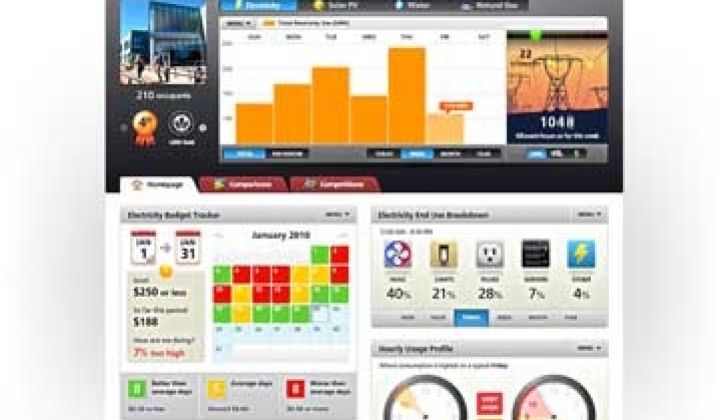Lucid Design Group is not the first company or utility to play into people's natural competitive impulses when it comes to lowering energy consumption targets. But it may be the first player to make it look so sleek.
Lucid, which provides real-time energy monitoring and display systems for buildings, is announcing its Building Dashboard Network today, a program that allows people to take their information and share it via social networking.
Tweeting your water use? You bet. Updating your Facebook status with how much you're saving on electricity? Go for it. But the software does not just play into pre-existing social networks, it also provides its own within Lucid's Building Dashboard interface.
"It's almost a little voyeuristic," said Michael Murray, Lucid's chief executive officer. "What means the most to people is not total kilowatt hours, because no one really understands what that means, it's how you compare to other people."
Over the past six years Lucid has provided its systems to about 400 buildings, including dorms and academic buildings at universities, commercial spaces and homes.
Let's say there's a friendly competition between 10 dorms to lower their electricity and water usage for two weeks. The buildings each have their own profile pages, which can include people who live or work there, and show their usage via graphs and animation. Users can see graphs that reflect usage rates over hours, days, months and years.
If graphs seem too vague, check out the animated gauges instead. When the little rubber ducky is donning a mask and snorkel instead of floating on top of the water's surface, it's probably a clear sign the building is using a greater-than-normal amount of water.
The social networking feature allows customers to see other building's usage and compare. Users can also choose to keep networks private, although Murray said that nearly all of their customers are looking to share the information.
Other features in the program include new widgets, and corporations and communities can also develop their own apps and widgets to customize their dashboards. If an underwater rubber ducky weren't much of a motivator, maybe the budget widget that tracks the money spent daily would drive home energy efficiency more effectively.
"We wanted to give people tools to map the relationship between the buildings and be able to communicate, compete and track goals," said Vladi Shunturov, Lucid's Chief Technical Officer. "Data alone doesn't really motivate people."
The new program allows green and LEED-certified buildings to showcase their sustainable features, from rooftop gardens to recycled carpeting.
The software has already been used in small competitions, but this year it will power a much larger showdown: the 2010 Campus Conservation Nationals, which pits about 40 U.S. universities against one another in a nationwide energy reduction competition in November.
It's not just for the sophomore set, however. Employers have used the Dashboard to communicate with employees, and the new networking features could allow employers to put a call out in demand-response situations, either explaining that the AC will be turned down for a few hours or ask employees to voluntarily cut down on energy usage.
Lucid has also seen facility managers use the program to challenge themselves, setting targets to reduce their usage during slow business hours.
There's already talk about some fraternities and sororities wanting to get their houses competing to cut down in energy use.
But why stop there? It would seem natural to take larger rivalries from college campuses, and maybe beyond, and challenge each other to slash energy use.
Ohio State vs. Michigan? Fenway Park vs. Yankee Stadium? Gavin Newsom's office vs. Michael Bloomberg's headquarters? Let the (friendly) competition begin.
Software & Analytics

Lucid Unveils Social Networking for Buildings
Lucid’s new product allows buildings to compare, and compete, head-to-head in energy use.

Lucid Unveils Social Networking for Buildings
-
41Where Will DOE’s Loan Program Make the Next Climate Tech Investments?
-
15What the Frack Is Happening With Natural Gas Prices?
-
9With an Energy Crisis Brewing, No Peak in Sight for Emissions



